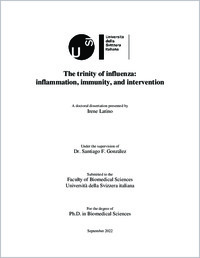The trinity of influenza: inflammation, immunity, and intervention
- Latino, Irene
- Gonzalez, Santiago Fernandez (Degree supervisor)
- 2022
PhD: Università della Svizzera italiana
Inflammation
Inflammatory waves
Influenza
Influenza virus
Immunopathology
Influenza vaccine
Dendritic cells
English
Influenza virus represents a major burden on human health due to the lack of efficient therapies to control disease progression. To develop new approaches for treatment and prevention against infection, a better understanding of the host-pathogen interactions that contribute to the progression of infection is required. In particular, understanding the innate immune responses against influenza virus represents a promising field for the early control of the infection and the priming of adaptive immune responses during vaccination. In this study, we comprehensively understood the most recent mechanisms involved in the initial inflammatory response triggered by influenza. First, we investigated the role of initial inflammatory response in the draining lymph node (LN) after influenza virus vaccination. Initially, we discovered that upon vaccination, LN macrophages (LNM) underwent inflammasome‐independent necrosis‐like death and released interleukin (IL)‐1α and interferon (IFN)‐β. We described the infiltration of neutrophils mainly via high endothelial venules located in the paracortical and interfollicular regions of LN dependent on the secretion of IL-1α. We employed a cutting-edge imaging analysis methodology to characterize the in vivo dynamics of neutrophil recruitment. Our results demonstrated that neutrophils displayed a patrolling behavior followed by the formation of swarms in the subcapsular sinus where neutrophils interact with macrophages and phagocytes influenza particles. Next, we demonstrated that IFN‐β was also necessary for activating early recruited NK cells in the LN, which produced high levels of IFN‐γ after vaccination. This peak of IFN‐γ was shown to be necessary for IL‐6 production by LN dendritic cells (LNDC). Altogether, the initial inflammatory cascade originated by macrophage death was required to generate an optimal humoral response against influenza virus after vaccination. Although vaccination is the primary strategy for the prevention and control of influenza infection, the discrepancies in vaccine efficacy raised a question about the role of pre-existing immunity on subsequent influenza vaccination. We demonstrated that pre-existing circulating antibodies that recognize the vaccine antigen and neutralize it by forming large aggregates, also called immune complexes, are responsible for antibody-mediated immune suppression. In this work, we demonstrated that immune complexes against influenza regulated the inflammatory responses by inducing a more anti-inflammatory phenotype in macrophages and decreasing the capturing and activation of LNDC. Finally, we described the connection between inflammation and innate immune response, identifying novel cell mediators involved in viral recognition and pathogen eradication, such as inflammatory dendritic cells and γδ T cells. In addition, we identified a novel mechanism for viral recognition associated with the expression of SIGN-R1 on inflammatory dendritic cells. In sum, our results provide insight into the orchestration of the early cellular and molecular events involved in immune protection against influenza. All the results obtained allowed us to propose new factors that guarantee the correct balance between the beneficial and the detrimental hyper-inflammatory condition to develop future therapeutic strategies to fight against influenza.
- Collections
- Language
-
- English
- Classification
- Medicine
- License
-
License undefined
- Open access status
- green
- Identifiers
-
- URN urn:nbn:ch:rero-006-120994
- ARK ark:/12658/srd1321955
- Persistent URL
- https://n2t.net/ark:/12658/srd1321955
Statistics
Document views: 194
File downloads:
- 2022BIOMED006: 200
